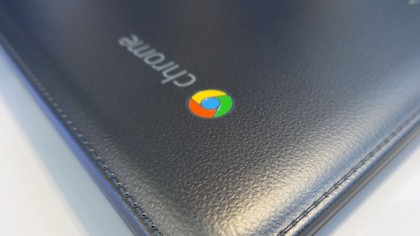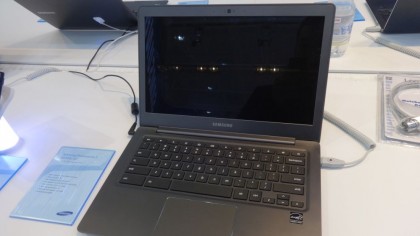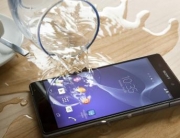
More laptops based on Google’s Chrome OS are hitting the market and Samsung’s second generation of Chromebook is testament to the resolute approach Google’s partners have adopted.
The Korean company had its Chromebook 2 11-inch and 13-inch Chromebooks on display at its booth at CeBIT 2014 in Germany, two models that it announced earlier this month.

The new Chromebooks (XE503-C12 and XE503-C32 respectively) will sell alongside the original one, bringing the total number of inventory units on the market to three. Prices in the UK have yet to be announced but we expect the 11-inch to retail for around £250 and the high-end, 13-inch model to hit £350.
Faux leather
The two models come with a faux-leather finish at the back of the screen. The material used is likely to divide opinions, as it did on its introduction at IFA last year with the Galaxy Note 3.

We briefly handled the two flavours of Samsung’s Chromebook 2. As a reminder, both come with an octo-core Samsung Exynos processor, possibly the Exynos 5410, which has four Cortex-A15 and four Cortex-A7 subprocessors in the dynamically scaling CPU configuration known as big.LITTLE. The A15 subprocessors are clocked at 1.9GHz on the 11-inch model and at 2.1GHz on the 13-inch one.
Apart from size and keyboard layout, the other major difference is screen resolution: the 11-inch model spans 1,366×768 pixels while the bigger Chromebook has a full HD resolution which falls short of Google’s high-end Pixel Chromebook but is still significantly higher than the rest of the competition.

That particular model was not working properly which meant that we couldn’t visually compare the screen quality on both Chromebooks. Expect the 13-inch model to be marginally sharper as it boosts a higher pixel density (170 vs 142ppi).
Hangout certified
These new Chromebooks are also the first to get an official Google Hangout certification. This means that Samsung has equipped both of them with dual array microphones, a 720p HD webcam and video processing capabilities.
The rest of the specs read as follows: 4GB of RAM, 16GB onboard storage, a webcam, HDMI port, two USB ports, a SD card slot and PowerVR graphics.
Battery life is rated at eight hours on the smaller Chromebook and slightly higher for the larger one. The model on the booth however showed only six hours capacity when fully charged.

Compared to the original Chromebook, the ports have been moved to the sides and the chassis has been modified with a larger touchpad.
The keyboard appears to be the only major letdown. The keys, while reasonably well spaced, were far too loose for our liking. Put it this way, we could hear the keys rattle when we shook the Chromebook (not that this is something you’d do often).
Matte plastic
The overall finish of both laptops is what you’d expect from a comparable entry-level, Windows-based laptop with matte plastic being the main material used in the chassis.
Oddly enough, the 11-inch model is thicker than its bigger counterpart (16.8mm vs 16.5mm) although lighter (1.2Kg and 1.4 Kg respectively).
Perhaps as a sign of the Windows-isation of the platform (pardon the neologism), Samsung also bundled a number of Chrome apps, in a way similar to how PC manufacturers bundle ‘bloatware’.
That said, two of them at least, Wunderlist Pro and Airdroid, are genuinely useful for both business and consumer users.
Early verdict
My encounter with the Chromebook 2 was brief and underwhelming. The faux-leather back is purely aesthetic and adds nothing to the functionality. Other than the extra onboard memory and the upgraded system-on-chip, there’s no major improvement to the 11in model. The new 13in model adds a bigger screen and a much higher resolution but that’s it. The good news though is that these new Chromebooks will almost certainly bring down the price of the existing Series 3 model. We will get a full review up shortly.
![]()













Hi admin, do you monetize your site ? There is easy way to earn decent money every month, just search on youtube :
How to earn $25/hour selling articles